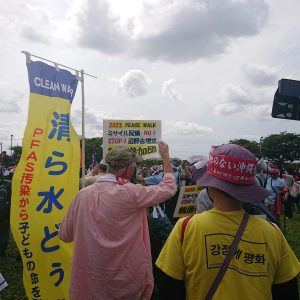Okinawa, the southernmost Japanese prefecture where many Japanese choose to spend their holidays thanks to its stunning beaches and rich cultural heritage, has evolved into the battleground of a long-running conflict. For over 60 years, the local populace has voiced its discontent with the presence of U.S. military outposts on the islands.
One of the key milestones in the history of Okinawa’s protests against the U.S. military presence occurred in the 1960s. At that time, the United States and Japan were negotiating the reversion of Okinawa to Japanese control. In 1972, Okinawa was finally returned to Japanese administration, marking the end of U.S. governance. However, the issue of the military bases remained unresolved, leading to ongoing protests and demonstrations in subsequent years.
Today the island hosts around 26,000 U.S. military personnel, about half of the total complement of the United States Forces Japan, spread among 31 areas. While Okinawa constitutes only 0.6 percent of the landmass of Japan, 70 percent of the U.S. bases in all of Japan are in the prefecture.
For the U.S. and Japanese governments, the grounds for the bases’ continued existence are obvious: to protect Japan’s security and foster regional stability. But the military outposts have grown to be divisive, straining relations between Okinawans and the United States, and between Okinawans and their own central government.
Fanning the flames of the local anger, in recent years new problems have emerged, like the presence of pollution in the groundwater.
On May 13, over a thousand people gathered for a peace walk along the main island of Okinawa. The next day, demonstrators held an annual symposium gathering all the peace groups of the country. Each year, similar events take place, centered around the May 15 anniversary of Okinawa’s reversion to Japanese control.
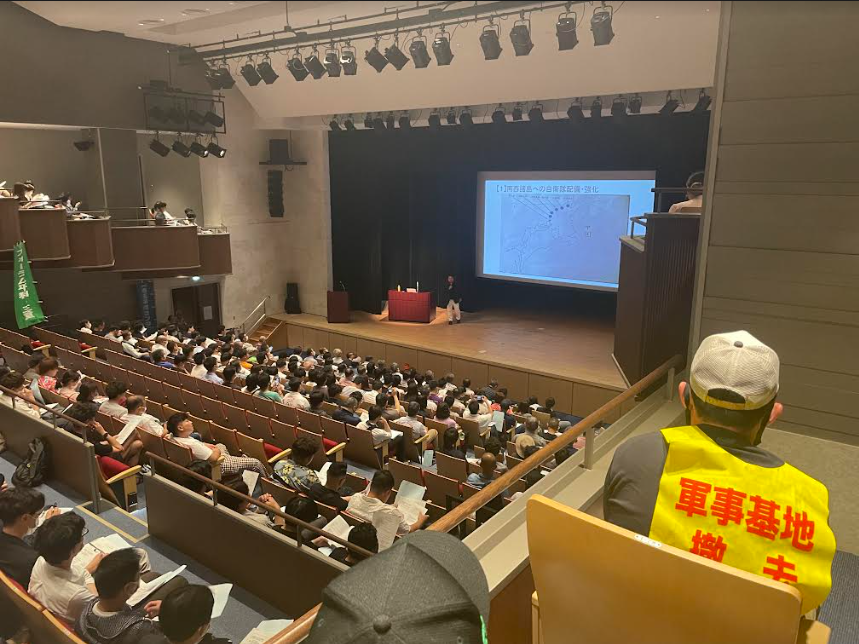
Hundreds of people gather at the Peace Action Center in Naha. (Cristian Martini Grimaldi)
Tani Masashi is the deputy secretary general of the Peace Forum. “This year marks 51 years since Okinawa came back to Japan and here we try to spread the knowledge to the young people of how strenuous the burden the American base has been to this island,” he said. “Our quality of life is the worst if compared to all other 46 prefectures.”
Okinawa’s economy has been heavily reliant on tourism and agriculture, which typically offer lower wages compared to industries such as finance and technology that are more prevalent in other parts of Japan.
“Japan’s main island is far from here so it is hard for the central government to fully understand our problems,” Masashi said. “Sure, many think if the American bases disappear also the local economy will be badly hit, but we have to think ahead on how to replace that void.
“Except for the older generation of Okinawans, people tend to take the American presence for granted because they never got to know what it was like to live on the island without foreign military personnel.”
Professor Ishikawa (who gave only his surname) delivered a lecture in Futenma Baptist Church near city hall in Chatan, a town located in Nakagami district, where more than half of the land area is currently occupied by U.S. military bases. He painted a very vivid picture of what the island used to be before the Americans settled in.
He started his speech by showing rare pictures of Okinawa before the war. “We had green fields, lots of land for agriculture and schools. It used to be a green wealthy island… War brought us so much change and not toward peace.”
More than once in his speech, Ishikawa stressed Okinawa’s past – and, he hopes, future – status as a “peace island without weapons.”
“Americans before the war was even over already started sending reconnaissance planes to take pictures from above so to prepare this island as a military outpost. Okinawans had their land expropriated without any say at all, all they could do was to resettle around the bases,” he claimed.
It took many years to mold Okinawan public opinion to gradually embrace the notion that the U.S. military installations were an intrinsic element of the islands’ essence. Ishikawa thinks it would take the same amount of time to make Okinawans think otherwise.
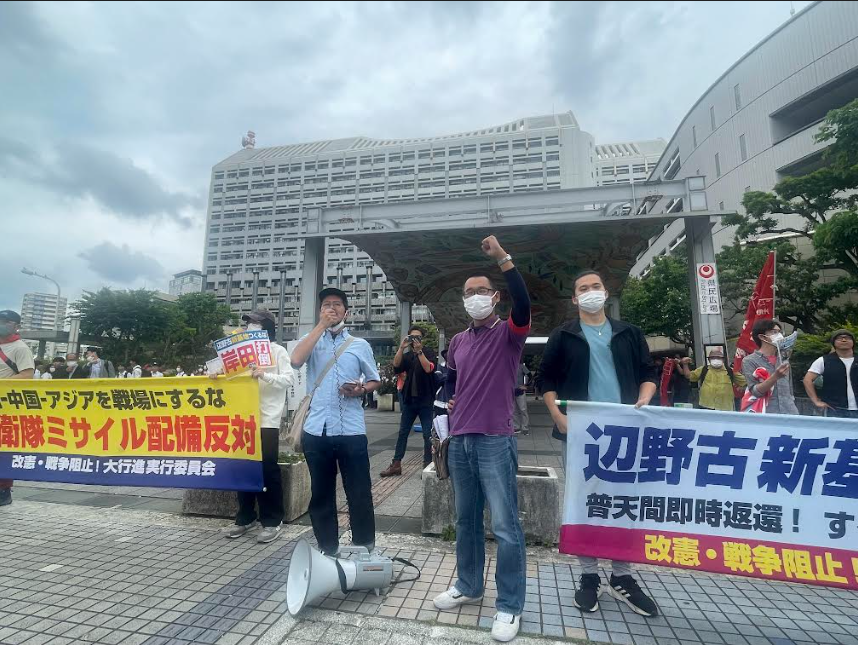
Peace Action demonstrators in Naha, in Japan’s Okinawa prefecture. (Cristian Martini Grimaldi)
While over a thousand people marched for peace in Yomitan Village on May 13, in the center of Naha a smaller group staged a demonstration. These demonstrations drew participants from all walks of life, including students, activists, local politicians, or merely concerned citizens, united in their fervent opposition to the presence of the military installations.
The military bases are becoming more and more critical for both U.S. and Japanese security policies as Okinawa prefecture turns into a key battleground in the rising tensions between China and U.S. allies in the region.
I asked Yuko, a 23-year-old student who came to Okinawa all the way from Kyoto, what it feels like to march for peace in such a volatile geopolitical environment.
“While it is true that many nations are currently pursuing militarization, it is crucial for us to focus our efforts on avoiding an escalation into an arms race scenario,” she said.
“The incidents that have occurred during the years, and the rapes to the locals, the environmental impact of the U.S. military all have had a significant influence on the lives of the Okinawan people,” said Yuto, 24, a local activist.
A couple of years ago, a group known as Okinawan Women Act Against Military Violence compiled a book to document 350 cases of sexual assault involving U.S. troops. One of the most recent was the brutal murder and rape of a 20-year-old by an American civilian contractor working at a U.S. military base.
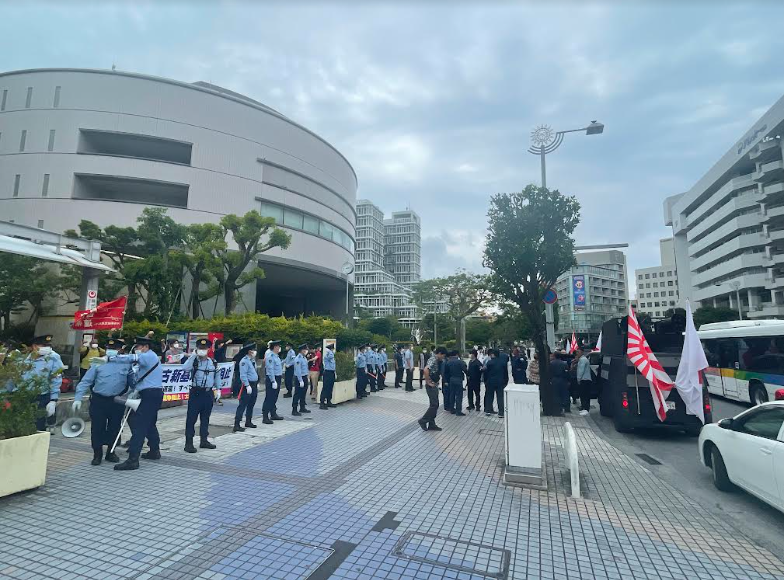
Peace demonstrators confronted by right-wing groups in Naha. Police formed a barrier to avoid clashes between the two groups. (Cristian Martini Grimaldi)
The peaceful demonstrators provoked the attention of right-wing groups, who came prepared with loud speakers and huge trucks to disrupt the march.
Ezaki-san, 52, is a truck driver who came from Chiba Prefecture, near Tokyo, to be here for the counter-demonstration. When the pacifists, a group of 40 people, spread their flags and banners he lost his temper and at least 10 policemen had to gather to overpower him. When he calmed down, I had time to sneak in between him and the security forces that were still holding on to him to ask him about his violent rage.
“They [the pacifist demonstrators] say we want war, but that is not true,” he fumed. “They are the ones who want to divide this country by being anti-Japanese!”
He is referring to the fact that the peace protesters display a noticeable sense of resentment toward the Japanese government. Tokyo’s willingness to accept the continued presence of military bases on the island stands in contrast to the prevailing sentiment of the local population.
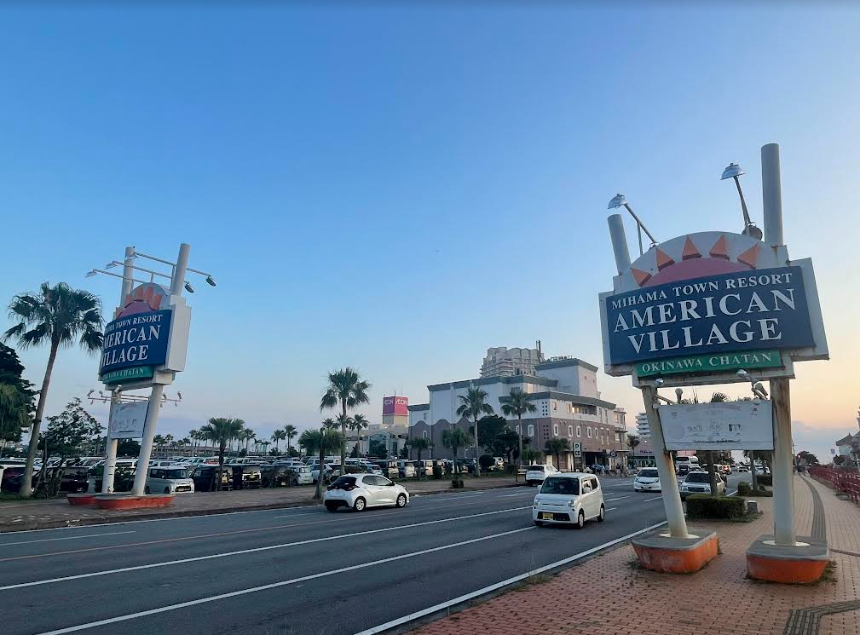
The American Village, an outdoor shopping mall in Okinawa. (Cristian Martini Grimaldi)
Later, I took a 90-minute bus journey to American Village, the famous rendezvous of all military stationed in Okinawa. You can spot the U.S. Marines at a glance; few foreign tourists here are in remarkable physical shape like they are.
I talked to a few of them who were lined up at a restaurant. They all seem startled by my question about the peace protest.
“I’ve heard about the demonstration but we never discuss this topic. I wouldn’t know much about it,” said Nicholas, a 22-year-old who arrived here just a few months ago from California.
This is essentially the answer I get from most of them, with some variations on the theme. Harry, a man with a big mustache and a U.S. Southern accent, expanded: “I heard it but it’s not an issue. We don’t lose any sleep over this. It’s way over my rank and salary to worry about it.”
Then I met Tom, 24, a tall blonde wearing sunglasses, who – to my astonishment – claimed to be the person responsible for a part of the leaks that have contaminated Okinawa’s drinking water, although it’s impossible to verify his claim.
“You know… we sometimes mess up… while filling the barrels with liquid… they spill over,” he told me.
What spills over? I ask.
“That stuff that goes into the trucks…” It was all I got from him before he promptly departed after his superior shot him a piercing gaze – indicating a possible dissatisfaction with his sharing of information.
The Environmental Preservation Division of Okinawa prefecture has raised concerns about a potential link between high levels of toxic PFAS contamination in groundwater samples and the presence of U.S. military bases. The division has also made a formal request to access the U.S. bases for further testing.
In a recent groundwater survey conducted by the prefecture, 46 sites near U.S. military installations were sampled, and alarming results were found: 32 of the sites exceeded Japan’s safe drinking water standard for PFAS. The most significant levels were discovered downstream of U.S. bases, particularly Marine Corps Air Station Futenma.
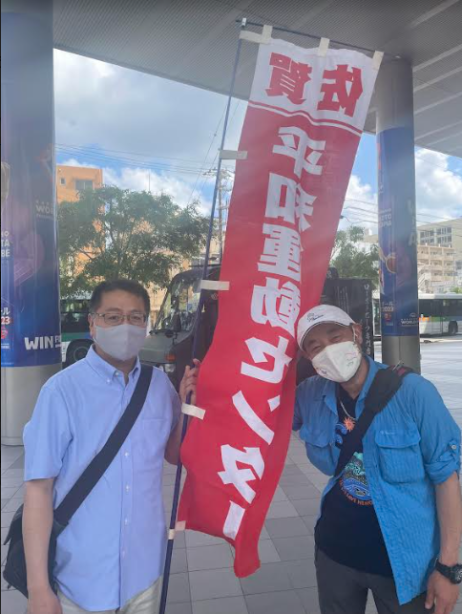
Demonstrators in front of the Peace Action center in Naha. (Cristian Martini Grimaldi)
PFAS are a group of man-made chemicals that have been widely used in various industrial and consumer products since the 1940s. One of the main concerns with PFAS is their persistence in the environment. They do not easily break down and can accumulate over time.
“Exposure to PFAS has been linked to potential health risks. Some studies have associated PFAS exposure with adverse effects on the liver, immune system and even thyroid gland,” said Toshio Takahashi, 70, whom I met at the Okinawa Prefectural Museum.
Toshio started his anti-base activities when he was 18 years old and has participated in dozens, if not hundreds, of demonstrations. He is part of the committee for the Life Protection Against the PFAS Pollution.
“The levels were measured in 2016 and we know they are over the accepted standard, so we ask that the soil water to be cleaned. But Japanese can’t get inside the base. In the U.S., the Americans are purifying the whole soil around the hundreds of bases they have there, but they are not doing so in their outposts abroad.”
Despite the prefecture’s requests for access to the bases for water sampling, they haven’t received any response so far. And so the issue is added to the lengthening list of grievances Okinawans have against the U.S. military presence on the home islands.













